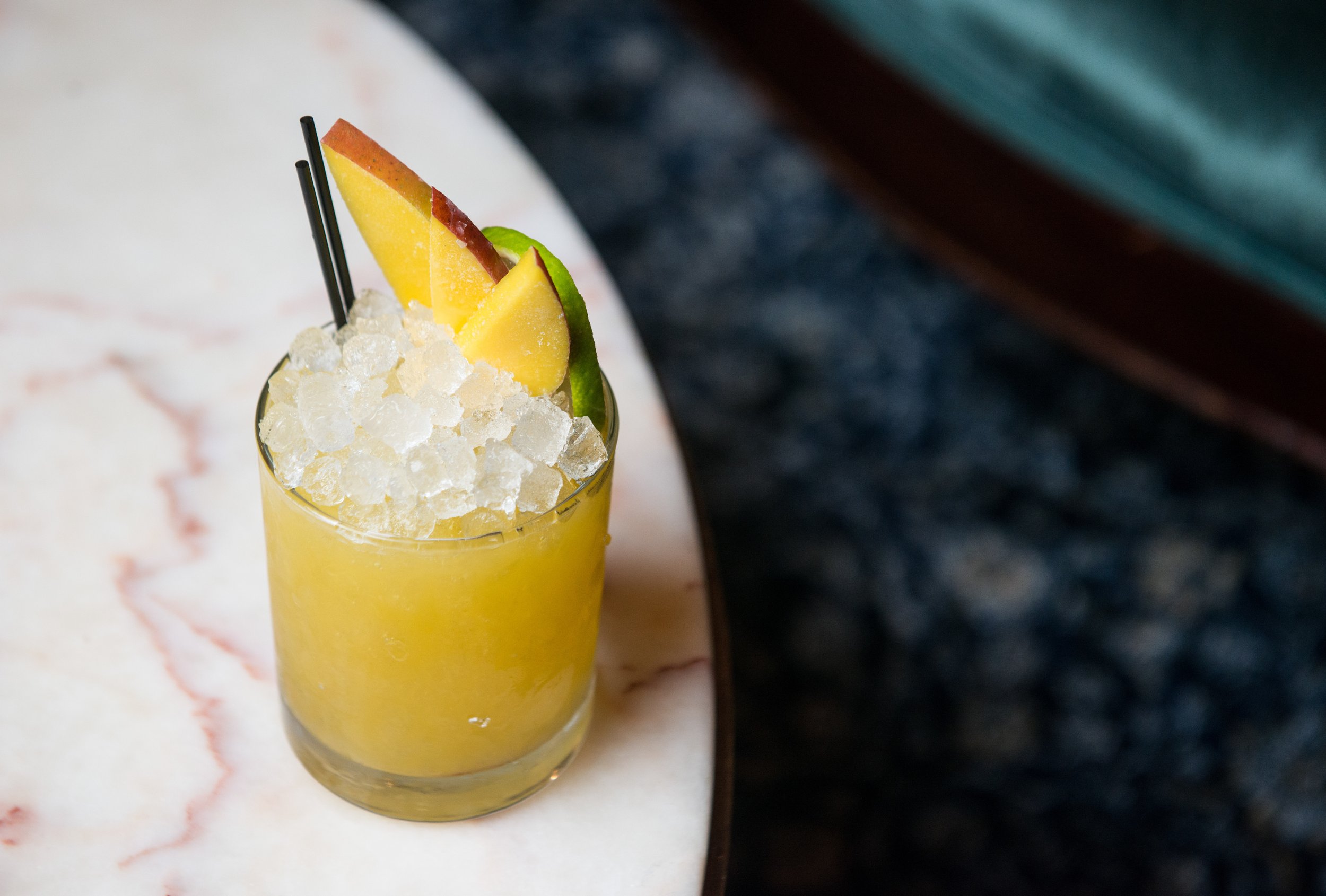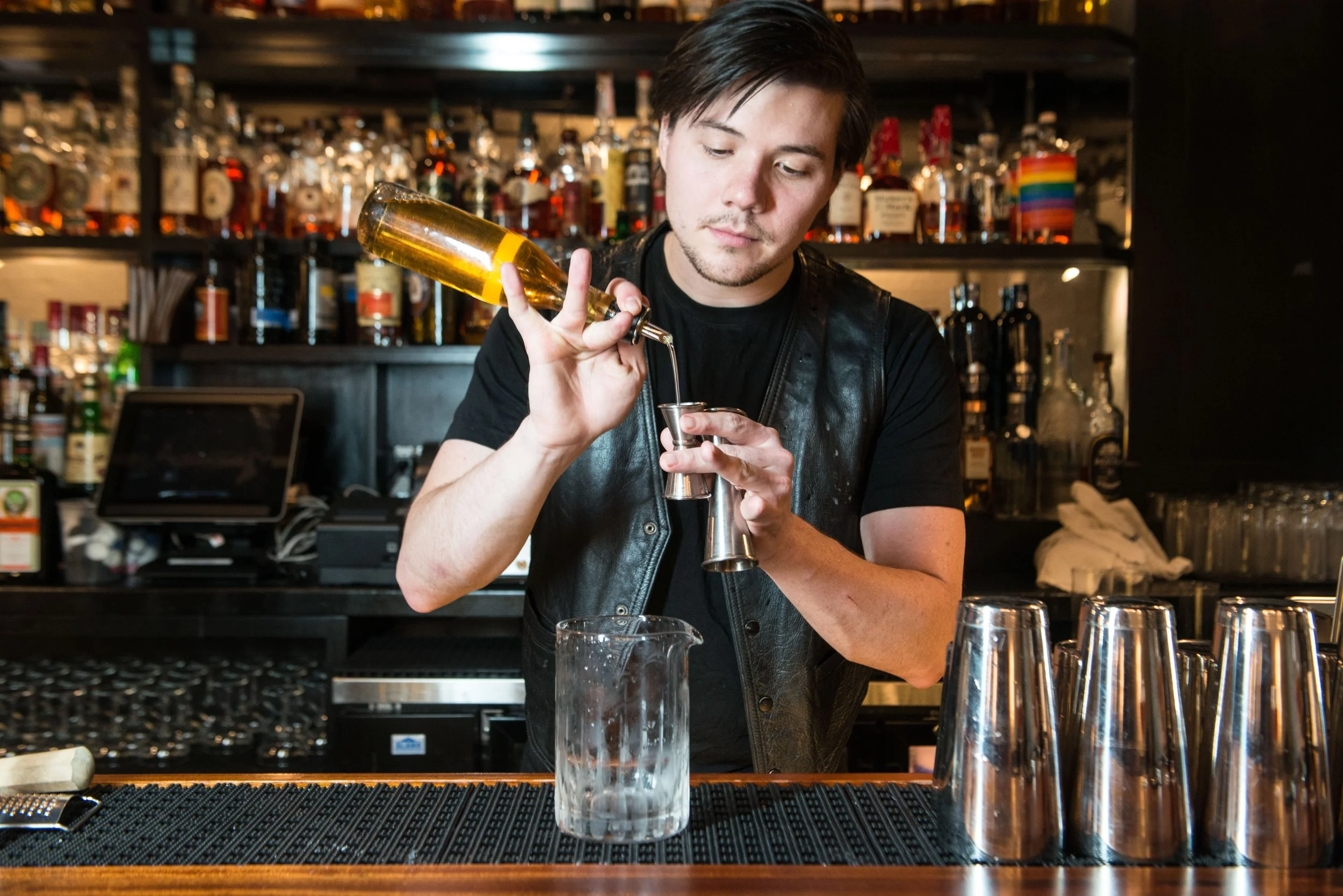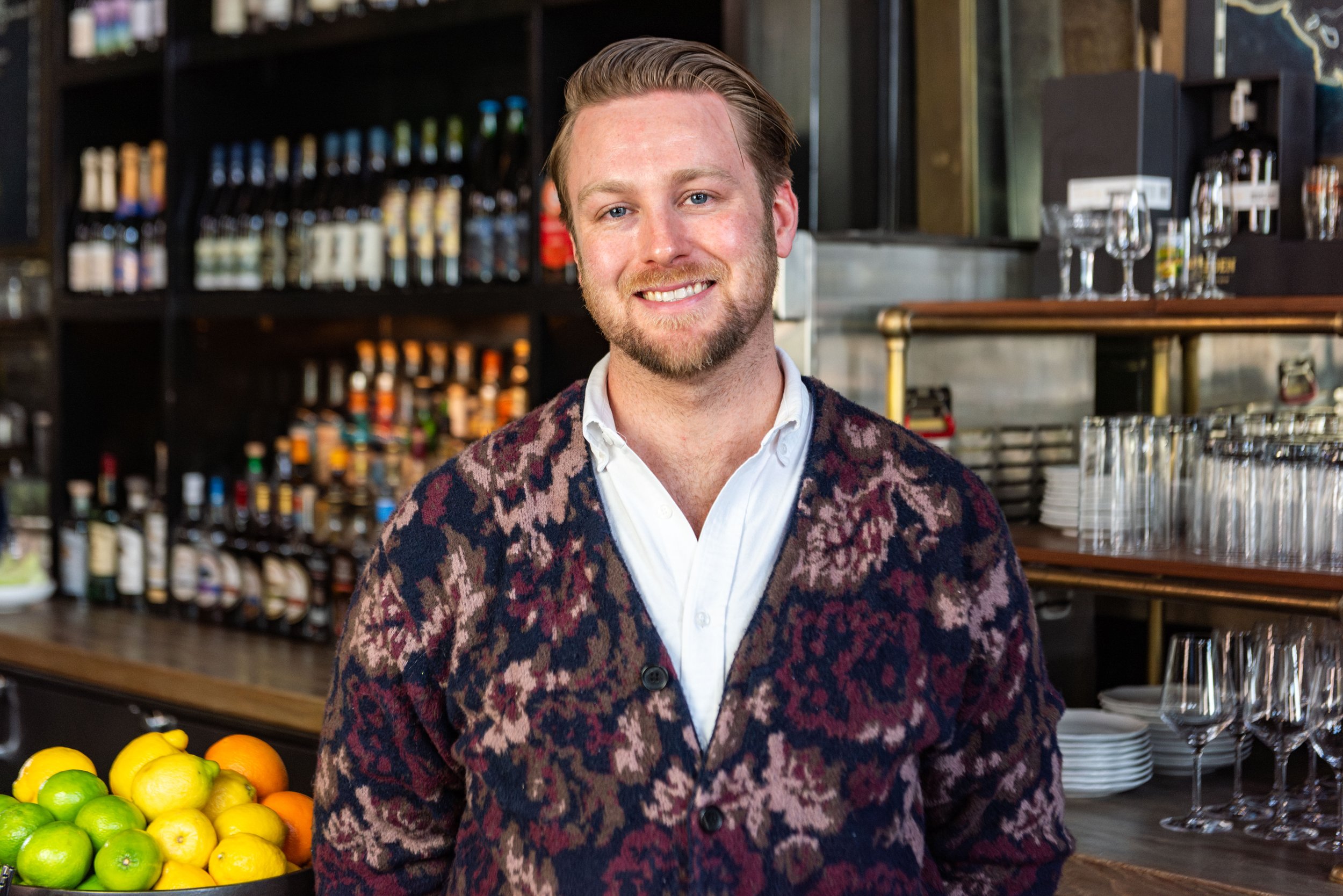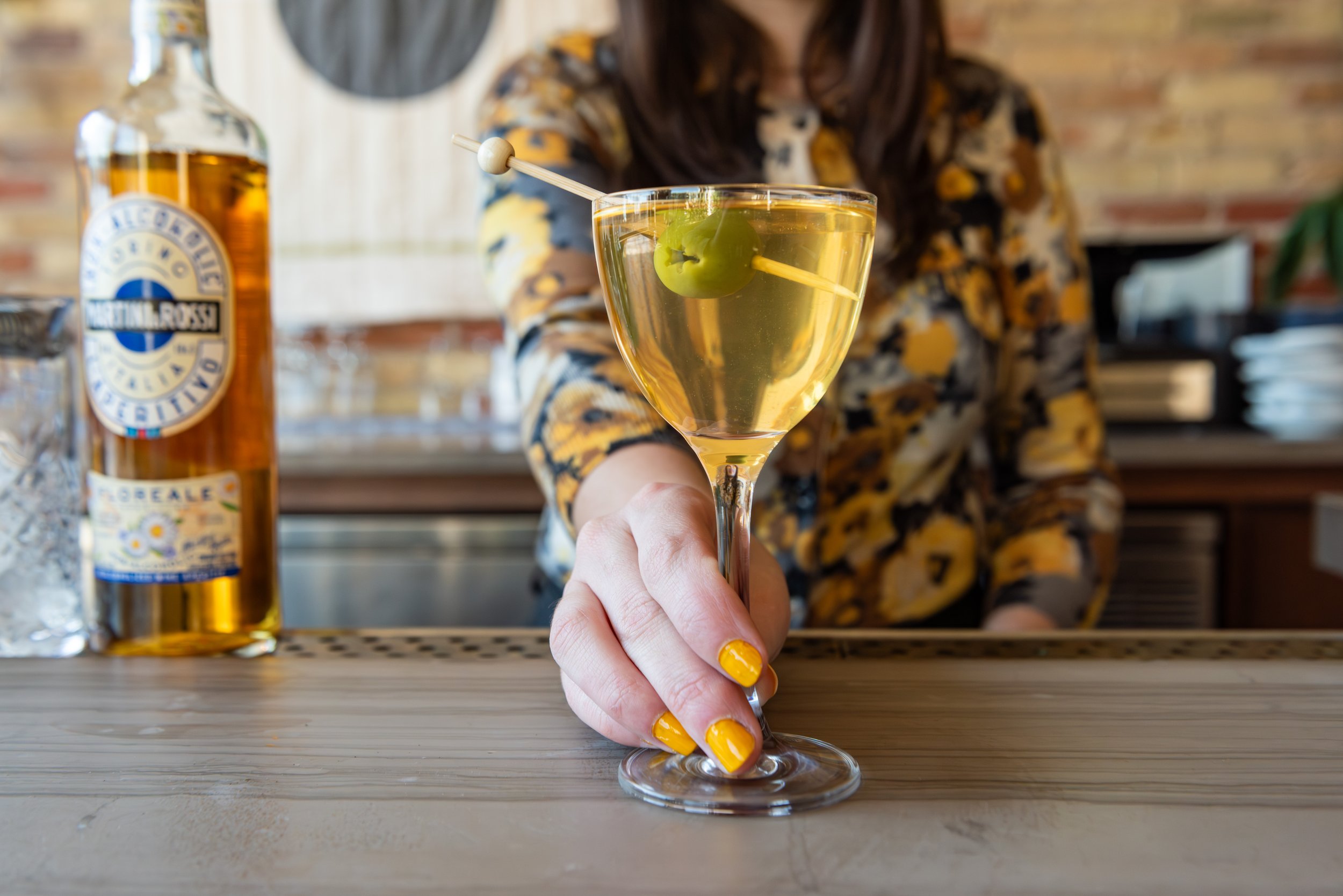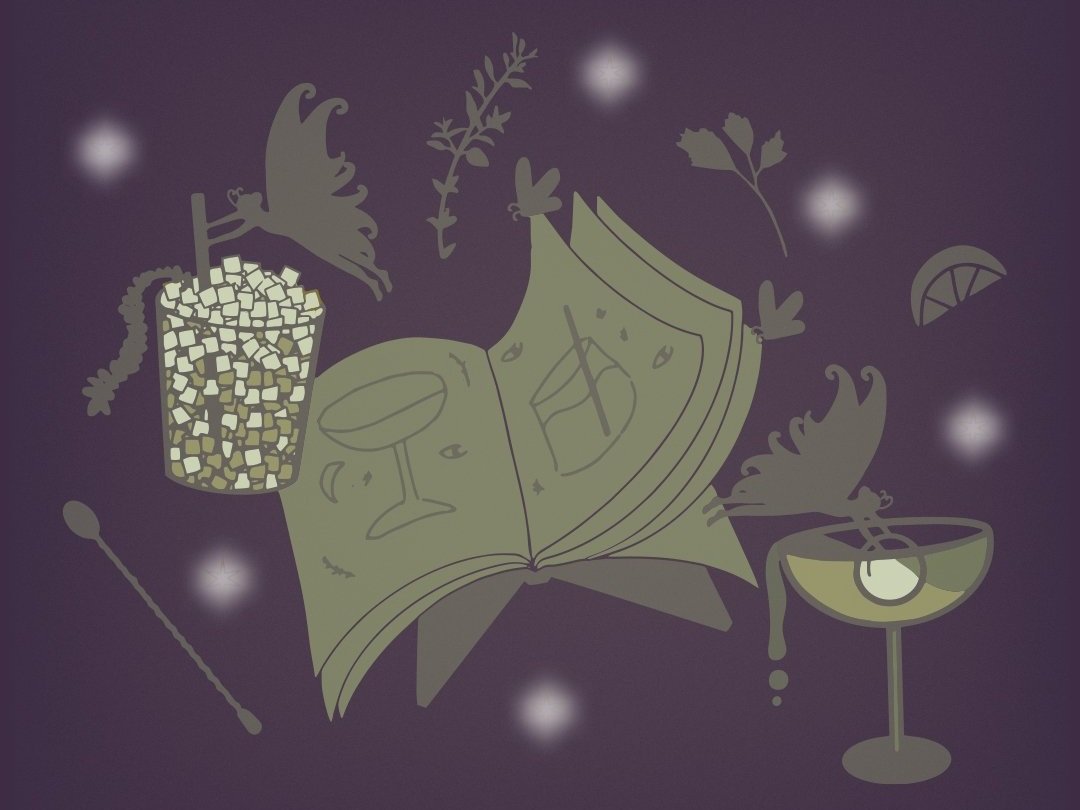Speed, Space, Complexity: The Batched Cocktail
Here are 10 ways to make batching work for your bar.
Aztec Negroni: Montelobos Mezcal, Campari, Martini & Rossi Riserva Speciale Rubino, Tempus Fugit Crème de Cacao, PX Sherry, Saline Solution, Birds Eye Chile Tincture, Mole Bitters, and House Spice Tincture
Stacey Swenson wanted to make a negroni that evoked the flavors of mole, a sauce that traditionally contains a minimum of 20 ingredients. Swenson’s Aztec Negroni comes close with 17 if you count each spice and the garnish. For all of the complexity she wanted to deliver, a nine-bottle pick-up is not in the realm of possibility at Dante, Linden Pride’s small Greenwich Village bar that’s stacked two deep most nights. Swenson’s solution (and Dante’s, in general) is a batched one-bottle pick-up.
“We’re one of the first bars that has been more transparent about batching,” says Swenson. “Cocktail bars have been doing it for a long time, keeping cheater bottles in the well and out of the eye of the customer. The perception is, perhaps, that you’re not putting in as much work, but guests are past the point where they want to wait 15 minutes for a cocktail.”
It’s a great time to be alive when you can get (and serve) an Aztec Negroni with the efficiency of a vodka soda.
Two-thirds of the 50-plus-item menu at Dante is batched or has batched components—including 13 negronis variations all lined up in reused 86 Co. bottles—plus four cocktails on draft. There simply isn’t room on the back bar for all the amari, fortified wines, and spirits required for Dante’s menu, so they’ve chosen variety, ticket time, and consistency over any “magic” that may be lost in a one-bottle pour.
Noche Sagrada: Horseradish-infused Mezcal, Krupnik, Cassis, Apple Cider, Ginger, Burnt Orange peel, and Baby's Breath at Sunday in Brooklyn
The Step Back: Capertif, Sfumato, Dolin Dry Vermouth, and Champagne Acid at Existing COnditions
The speed of service enabled by batching translates into better hospitality and more cocktails sold. At Dave Arnold and Don Lee’s Existing Conditions, guests (including a certain editor) can drink a self-serve bottled martini or Manhattan while they wait for a table or seat at the bar. “It’s all about reducing touches and decreasing ticket times,” says Existing Conditions’ Bartender Jack Schramm.
“There’s this romantic idea of the experience where your bartender builds a drink from the ground up, but hospitality is more important,” says Bartender Brian Evans of Sunday in Brooklyn. Four bottle touches is the sweet spot for his culinary-driven program. It’s still a show for guests, and it leaves time for meticulous garnishing. “Often, our garnish work takes longer than building the cocktail itself. We set herbs on fire and dust drinks with powdered sugar. Because we batch six ingredients, there’s wiggle room to go wild on presentation.” Evans sees firsthand the powerful “sizzling fajita effect”: when a server walks through the dining room with a garnished-to-the-hilt cocktail, everybody wants one.
At Dante, too, aesthetics are important. The house Pimm’s Cup has nine garnishes. Even though all the alcohol is batched, it’s still a 10-step drink (hello, Instagram). “Batching gives us time to really take care of each drink, to make sure it looks perfect when before we send it out,” says Swenson.
For Will Pasternak, a batching whiz who recently earned the title of head bartender at BlackTail, the ideal pick-up involves five or fewer bottle touches, even as ingredient numbers climb into the double digits. Unlike Dante or Existing Conditions, there are no 100 percent batched, bottled, and ready-to-serve drinks on their menu, but Pasternak has found other efficiencies.
Bartender Will Pasternak of BlackTail
Moral Dilemma: Aged Genever, Cynar, Fino Sherry, Amontillado Sherry, Vermouth, Aquavit, Lemon Juice, and Umami Bomb at BlackTail
Let’s say a team member designs a 3 ounce drink that everyone loves and has gone through BlackTail’s exhaustive R&D process. When it comes time to run costs, though, the cocktail exceeds their 20 percent ideal. Batching saves the drink: they can tinker with numbers and adjust the pour to a 2½-ounce serving.
Pasternak also says that batching allows him to more precisely dial-in flavor. There are only so many utensils and measuring vessels you can use during service. A drink he worked on recently called for 1 teaspoon of two syrups. By combining them in a single bottle, he found that he could decrease the amount of total syrup to 1½ teaspoons and still measure with ease (rather than ½ teaspoon plus ¼ teaspoon times two).
“You can either scale up a recipe, add up the numbers, and that’s the batch pour, or you can scale up, make the batch, and determine the pour size,” says Pasternak.
As the industry works on taking better care of its own, the efficiencies of batching add up to fewer repetitive motions and physical work. BlackTail’s most popular cocktail right now is the nine-ingredient, four-touch Foliage. “We save five bottle touches per cocktail, 30 times a night. It adds up,” says Pasternak. He has also stopped using 750-milliliter bottles for components that are required in small quantities; 8-ounce bottles make it through service and reduce wrist strain. “Maybe someone can work more because they’re not burned out. Guests don’t care how hard it is for you. They just want consistent drinks.”
Saving effort during service doesn’t necessarily mean adding a ton of (if any) additional labor to pre-shift work. Most programs have shifted the work of barbacks to include more component and cocktail batching. “Our barbacks have always been hands-on,” says Bartender Leanne Favre of Clover Club. “Batching allows them to see the ingredients, touch every part. We have drinks that are completely batched out—stirred cocktails and nogs. Barbacks are making drinks, essentially. There’s a lot of cross training here.”
Shuck & Jive: Oyster Shell-infused Vodka, Lustau Manzanilla, Edinburgh Seaside Gin, Dolin Blanc Vermouth, Seaweed Shrub, Oyster Sidecar, and Lemon Wedge
Bartender Leanne Favre of Clover Club
Dante rotates through barbacks and bartenders to batch six days a week. Existing Conditions has a full-time prep person for syrups and “simple” infusions (you know, the kind that involve a Spinzall), but their bar staff comes in before service for more delicate batching work. BlackTail and Dead Rabbit share a fulltime syrup maker, but the work of batching falls into their existing labor costs.
Over at Broken Shaker, Bartender Brian Hawkins has a kitchen team do all his juicing and batching. “Our labor shrinks, and I have someone with actual culinary experience making syrups. We also have a giant deli slicer for all our garnishes. We can do eight limes at a time,” says Hawkins.
Hawkins is a master of draft cocktails, and he bristles at self-imposed limits that bars put on batching. He adds citrus, syrups, and other perishable items to his kegs. “People need to stop being scared. Once it’s pressurized in a keg, it slows way down in terms of degradation. If you’re doing enough volume, it doesn’t matter what you put in there, as long as it’s not pulpy. You just have to double strain to get particulate out of the cocktail.” (In a monument to bartender ingenuity, Hawkins drops a large vibrator—yes, that kind—into draft cocktails to keep them agitated and uniformly mixed for every guest.)
Air is the enemy. At Existing Conditions, Schramm and the team root out oxidation with a shot of liquid nitrogen to each of their bottled cocktails. “I’ve run tests. I have martinis from Booker and Dax that are 2 years old, with the date on the cap. I opened one recently, and it was a perfectly preserved martini,” says Schramm.
If your bar isn’t bottling oxygen-free drinks or floating a keg of cocktails each night (about 80 to 100 drinks), you may need to follow a few more rules. Because bitters don’t scale reliably, most bartenders (even Hawkins) avoid including bitters in batches, and instead add them to drinks during service. Swenson is the exception: she’ll “add and taste add and taste” bitters to her batches.
The team at BlackTail combines elements based on density and shelf life—liquor with liquor, syrups with syrups. Pasternak doesn’t batch juices or fortified wines, though plenty of bars batch the latter as volume allows. Favre has had success batching syrups with liquor, but she says there’s potential to waste (or ruin) your most expensive ingredient if you do so.
Everybody has an off day, but “batching multiplies your mistakes,” says Pasternak, who along with Schramm, swears by the graduated cylinder for measuring.
Bartender Jack Schram of Existing COnditions
Havana Honey Bear: Cumin Honey, Apricot Combier, Amontillado Sherry, Amaro Montenegro, and Pineapple at Sunday in Brooklyn
“The graduated cylinder is the paragon of accuracy, so there’s much less margin for error. We’re measuring in milliliters,” says Schramm. Consistency is the goal and one of the primary benefits of batching, and it’s critical to taste at every step of the process. Bartenders, barbacks, and servers should all be able to detect small inconsistencies. And it’s important to date and initial batches so that if something does go wrong, you can figure out when and why it happened.
In the event of a miscalculation, you have a few options. Most bars work backwards and tinker with the batch until it’s delicious. Other times, you might have to use the batch or product for something else. Schramm once made a pineapple-infused mezcal with a slightly inferior, more desiccated dried pineapple than usual. The mezcal couldn’t be used for an on-menu cocktail, but he dropped the bottle on an industry birthday party. His screw up made him a hospitality MVP. You can also save the mistake for an event cocktail.
For Brian Evans and an accidentally garlic-infused cocktail at Sunday in Brooklyn, there was only heartache, the drain, and an important lesson: always sniff your delis.







